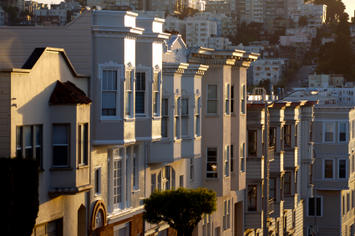
On any given weeknight in San Francisco, some professional, political or social association throws a cocktail hour. From black-tie galas in the latest hip restaurant to arts fundraisers held at dingy watering holes, these mixers are a staple of young professional life where people go to network, flirt and unwind.
A recent event was packed with young, clean-cut white and Asian office workers. Everybody was affable, ambitious, smartly dressed and beaming with apparent confidence. In conversation, I learned that almost nobody was from here; some had only been here a few months. We talked about our careers, the coming summer’s travels and, being a largely twenty-something crowd, the best places to get fall down drunk. It was not an unpleasant way to pass the evening.
Yet, as I walked back to my car through the cool streets, an emptiness lingered: the déjà vu of too many jaunty conversations at other cocktail hours. They reminded me of the breezy talks had in youth hostels the world over; and like any youth hostel, it seemed obvious that if I were to go to the same place a year later it would be an entirely different group of people. The exuberance would remain the same, but the faces would not.
Undoubtedly, San Francisco is one of the great American cities – and perhaps its most beautiful. The thick fog that charges into the city at all times of year and the colorful Victorian homes that line the streets like dominoes create a charm few other cities anywhere can match. Certainly, it is not the cleanest American city, but it feels among our most loved judging by the stream of visitors and the upkeep of its buildings.
Of course, many cities are beautiful, but what makes the town truly unique is its sense of place. Take a snapshot of a street in Los Angeles and it could pass as Denver, Dallas or Orlando, but when I walk on Irving, Hayes, Mission or Grant streets, I know without doubt that I am in San Francisco and no other place. The large stone edifices and doormen of Nob Hill recall Manhattan, but the ring of the cable car and the sudden, unexpected views of the Bay remind me that I am nowhere but here.
And yet, there lies the great paradox of “the City” as locals like to call it: it is a place at once very personal and impersonal. Its geography, architecture and quirky culture are truly unique, and yet much of the City’s population consists of a revolving door of restless youth who stay for a few years before leaving.
The concentration of entertainment, great cuisine, culture, and educated people give the city a verve and zest that few can match, but this lifestyle does not translate as well to young families: the City has the lowest percentage of its population under the age of 18 of any U.S. city. The City’s famously high cost of living makes it difficult to buy a home within city limits for under $700,000. Lots of condominiums cost more than that. Faced with this unpleasant economic reality, it is no wonder that many people move on after a couple of years.
It is very tempting to want to place a value judgment on all this, to say that a city with as restless a population and few families offers only fleeting moments of adult enjoyments to a rotating list of players; certainly the more sublime satisfactions of being firmly rooted in one community, owning property and raising a family are increasingly out of reach for many residents.
Besides the cost of living , the uber-liberal climate may also eventually nudge many people and business from San Francisco. But perhaps it’s OK --- in a nation of 300 million headed towards 400 million --- for a city to thrive as a “one-industry town, strictly in the pleasure dome business,” to quote Tom Wolfe’s description of Manhattan a few years ago. Few towns exhibit the urban high-life as well as San Francisco while retaining a close proximity to mountains, beaches and pristine forests.
The real question then becomes: how much meaningful community can one find in cities like this, where people move in and out with great frequency, where transience is a norm rather than an exception? What sort of lives do we lead when we move on every few years and when friendships that we’ve invested time into do the same?
As Robert Putnam writes in his seminal work Bowling Alone, “Communities with higher rates of residential turnover are less well integrated… Mobility undermines civic engagement and community-based social capital.” Not suprisingly social capital indexes generally ranks cities like San Francisco rather poorly.
Thinking back to the cocktail party, I wish I could put tags on the people I met that night and see where they would be in five years. I think if I walked into the same place then, I would be greeted by a fresh group of well-manicured and confident peers talking about the newest excitements to be experienced in this land of high cosmopolitania.
But where would be the people I saw? My guess is not in San Francisco. In Redwood City or Benecia, perhaps, or in the Midwestern or East Coast towns they grew up in, watching their toddlers run through their backyard talking about the time in their youth when they did “the San Francisco thing.” And man, it was a blast.












